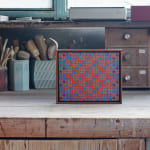Onosato Toshinobu (1912–1986)
Work
Oil on canvas, framed
Signed by the artist on the back
1964
22.5 x 27.5 cm
25 x 30 cm (overall)
According to Onosato Toshinobu’s own words, there is a period of transition in his works from “solid circles” to “divisions of circles.” The circle as a motif first appeared in Onosato’s paintings around 1955. In March of that year, the Minori Costume Show took place at the Kiryu Textile Hall in Kiryu (Gunma Prefecture). Several small paintings by Onosato decorated the venue. In one of them, a circle and a square were arranged in the center, exemplifying the “solid circle” approach.
Work has a sticker of Minami Gallery attached to the back of the wooden frame of the canvas, reading “artist Toshinobu ONOSATO” on the first line, then “title [ ] 1964” on the second, and the name and address of the gallery, “minami gallery 3,3-chome…,” on the third. Onosato exhibited at Minami Gallery since 1962; the present work is a comparatively early example of his “division” period. He once described his artistic principles as follows: “My works belongs to the realm of physics, there is nothing painterly about it. I was always most interested in physics. I ended up somewhat on the sidelines of art, but I have never been involved in the ‘human drama.’ Just as physics has objects, force relationships and symbols called numbers, I have shapes and colors” (Onosato Toshinobu, “From Basic Form and Color,” Bijutsu techo, August 1962). In 1931, Onosato had enrolled at the electrical engineering department of Nihon University, but he eventually dropped out. In his essay “On My Painting,” he describes the “birth” of the circle: “In the beginning, it was a lump of clay. I discovered the circle in all its simplicity. I layered it with a series of small squares that filled the screen. From there, the science of color and form began for me,” he recalled. “A circle doesn’t have an outline, it is just a precisely delineated flat surface. By dividing it into smaller units, its area becomes more tangible. The division of the circle creates a psychological and rectangular tension from the overlapping of colored surfaces, and transforms the abstract plane into a real object. Though a circle is a form, I tend to not think of it that way” (Onosato Toshinobu, “On My Painting,” in ONOSATO, 1989). Thereafter, the artist would continue to paint circles that fill the picture plane in complex, multifold layers.
Onosato Toshinobu (painter; 1912–1986)
Painter from Nagano Prefecture. Onosato studied at the private art school of Tsuda Seifu. Co-founder of the Free Artists Association. During the war, he was drafted into military service in Manchuria, and later experienced internment in Siberia. As a pioneer of Japanese abstract painting, Onosato was active internationally. His preferred subject matter was the circle. Onosato’s works were selected for the Nikakai, and he received the Grand Prix of the Japan International Art Exhibition.
Work has a sticker of Minami Gallery attached to the back of the wooden frame of the canvas, reading “artist Toshinobu ONOSATO” on the first line, then “title [ ] 1964” on the second, and the name and address of the gallery, “minami gallery 3,3-chome…,” on the third. Onosato exhibited at Minami Gallery since 1962; the present work is a comparatively early example of his “division” period. He once described his artistic principles as follows: “My works belongs to the realm of physics, there is nothing painterly about it. I was always most interested in physics. I ended up somewhat on the sidelines of art, but I have never been involved in the ‘human drama.’ Just as physics has objects, force relationships and symbols called numbers, I have shapes and colors” (Onosato Toshinobu, “From Basic Form and Color,” Bijutsu techo, August 1962). In 1931, Onosato had enrolled at the electrical engineering department of Nihon University, but he eventually dropped out. In his essay “On My Painting,” he describes the “birth” of the circle: “In the beginning, it was a lump of clay. I discovered the circle in all its simplicity. I layered it with a series of small squares that filled the screen. From there, the science of color and form began for me,” he recalled. “A circle doesn’t have an outline, it is just a precisely delineated flat surface. By dividing it into smaller units, its area becomes more tangible. The division of the circle creates a psychological and rectangular tension from the overlapping of colored surfaces, and transforms the abstract plane into a real object. Though a circle is a form, I tend to not think of it that way” (Onosato Toshinobu, “On My Painting,” in ONOSATO, 1989). Thereafter, the artist would continue to paint circles that fill the picture plane in complex, multifold layers.
Onosato Toshinobu (painter; 1912–1986)
Painter from Nagano Prefecture. Onosato studied at the private art school of Tsuda Seifu. Co-founder of the Free Artists Association. During the war, he was drafted into military service in Manchuria, and later experienced internment in Siberia. As a pioneer of Japanese abstract painting, Onosato was active internationally. His preferred subject matter was the circle. Onosato’s works were selected for the Nikakai, and he received the Grand Prix of the Japan International Art Exhibition.



